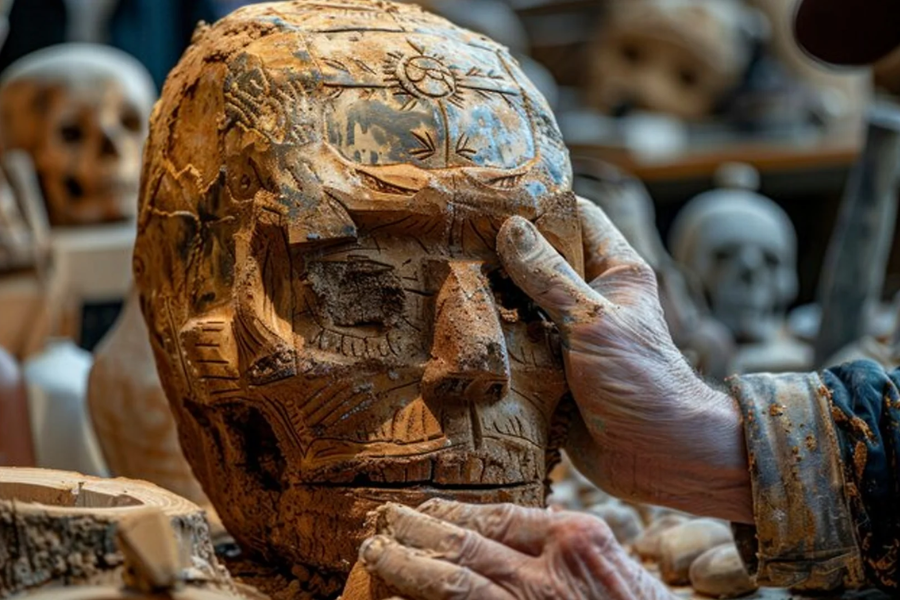The Persistent Legacy of Ancient Artz: Echoes of Time And More Explore
Art has always been a vital part of human existence, reflecting our history, beliefs, and values. From the first cave paintings to the monumental sculptures of ancient societies, art has shaped cultures and influenced generations. The term Ancient Artz refers to the vast spectrum of artistic expressions created by early civilizations, ranging from prehistoric times up to the fall of empires like Greece and Rome. This art form offers us a unique window into humanity’s soul, captivating people today with its beauty, intricacy, and emotional depth.
The Essence of Ancient Artz
Ancient art was far more than decorative—it was a key medium for storytelling, religious expression, and conveying social norms. The artists of these eras were often seen as the keepers of divine messages, cultural narratives, and historical records. Each ancient civilization contributed its unique flavor to the collective body of Ancient Artz, creating timeless works that continue to resonate through the ages.
Art in ancient times took many forms, including paintings, sculptures, pottery, textiles, and architecture. Each object, whether a simple pottery fragment or an awe-inspiring temple, tells a story. Whether depicting gods, heroes, or everyday people, ancient art was deeply narrative, showcasing the universal power of storytelling.
Ancient Artz: A Global Journey
The world of Ancient Artz spans countless civilizations, each contributing distinctive styles, techniques, and themes. Key artistic achievements come from regions like Mesopotamia, Egypt, Greece, Rome, the Americas, and Asia. Below, we explore some of the most influential civilizations and their contributions.
Mesopotamian Art: The Dawn of Civilization
Mesopotamia, often called the cradle of civilization, produced some of the earliest known artworks. The Sumerians, Akkadians, Assyrians, and Babylonians left behind a treasure trove of artifacts, including stone reliefs, statues, and intricate cylinder seals. Much of their art depicted religious themes, with gods and rulers often portrayed as towering, godlike figures to emphasize their importance.
One standout example of Mesopotamian art is the Stele of Hammurabi, a monumental stone pillar inscribed with one of the world’s earliest law codes. For these early civilizations, art served not just as decoration but as a crucial means of communication, documenting laws, events, and religious beliefs that governed their societies.
Egyptian Art: Immortality in Stone
Egyptian art is famous for its consistent style, which reflected the Egyptians’ deep concern with the afterlife. Artists created works meant to accompany the dead in their journey to eternity, including grand statues, tomb paintings, and elaborate jewelry.
Perhaps the most iconic example of Egyptian art is the Great Sphinx of Giza, a massive limestone statue symbolizing strength and protection. The vividly painted tombs, such as those found in the Valley of the Kings, give us a detailed glimpse into ancient Egyptian life, illustrating daily scenes, religious rituals, and the journey to the afterlife.
Greek Art: The Pursuit of Perfection
Ancient Greek art laid the groundwork for much of Western artistic tradition. Greek artists sought to represent the ideal human form, with a focus on proportion, harmony, and beauty. Greek sculptures achieved an unparalleled level of realism, capturing the movement and vitality of the human body.
Famous sculptures like the Venus de Milo and the Laocoön Group highlight the Greeks’ mastery of depicting human anatomy and emotion. Their pottery, too, was adorned with detailed scenes from mythology and daily life, reflecting the Greeks’ artistic excellence and attention to storytelling.
Roman Art: Grandeur and Realism
Roman art, heavily influenced by Greek traditions, is known for its realism and architectural splendor. Roman artists excelled in sculpture and architecture, creating monumental public works like the Colosseum and the Pantheon. Roman portraiture, such as busts of notable figures like Julius Caesar, showcased an unflinching realism, capturing not just beauty but also the flaws and imperfections of their subjects.
Asian Art: Spirituality and Nature
In Asia, ancient art was deeply intertwined with religion and the natural world. Chinese art, for example, featured exquisite pottery, bronze work, and calligraphy, often reflecting Confucian, Taoist, and Buddhist ideals. Indian art is renowned for its temple carvings and statues, particularly depictions of gods like Vishnu, Shiva, and Buddha.
China’s Terracotta Army, a massive collection of clay soldiers buried with Emperor Qin Shi Huang, stands as one of the most impressive examples of ancient Chinese artistry. Similarly, India’s Ajanta Caves, adorned with vibrant murals depicting the life of the Buddha, represent the spiritual depth and craftsmanship of early Indian art.
The Lasting Influence of Ancient Artz
Although these ancient civilizations have long since fallen, their artistic legacies live on. Ancient Artz offers modern audiences a glimpse into the minds and hearts of people from millennia ago, helping us understand their cultures and values. For contemporary viewers, this connection to the past enhances our appreciation for human creativity and diversity.
Today, museums around the world preserve and display these ancient works, inspiring artists, historians, and the public alike. Whether through the monumental statues of Egypt or the detailed pottery of Greece, Ancient Artz continues to serve as a bridge between the past and present, celebrating the timeless beauty of human expression.
Summary
Ancient Artz represents a wide range of artistic expressions from early civilizations, reflecting humanity’s history, beliefs, and values. This art form encompasses various mediums—paintings, sculptures, pottery, textiles, and architecture—serving as powerful storytelling tools and expressions of social and religious norms.
The article explores the contributions of significant ancient civilizations, including:
- Mesopotamia: Known as the cradle of civilization, it produced early artworks, including the Stele of Hammurabi, which documented laws and religious themes.
- Egypt: Renowned for its focus on the afterlife, featuring iconic works like the Great Sphinx of Giza and elaborate tomb paintings.
- Greece: Pioneered the representation of ideal beauty and human form, with famous sculptures like the Venus de Milo showcasing their artistic excellence.
- Rome: Emphasized realism in art and architecture, evident in monumental structures like the Colosseum and realistic portraiture of historical figures.
- Asia: Focused on spirituality and nature, with notable contributions from Chinese and Indian art, including the Terracotta Army and Ajanta Caves.
Despite the fall of these civilizations, the legacy of Ancient Artz endures, offering modern audiences insights into past cultures and enhancing appreciation for human creativity and diversity. Museums worldwide continue to showcase these works, bridging the past and present.
Facts:
- Diverse Mediums: Ancient Artz includes various forms such as painting, sculpture, pottery, textiles, and architecture, each serving different purposes in society.
- Storytelling: Much of ancient art was narrative, depicting gods, heroes, and everyday life, reflecting cultural values and beliefs.
- Mesopotamian Contributions: Mesopotamia’s artifacts, like the Stele of Hammurabi, were not only decorative but also served as historical records.
- Egyptian Focus on Afterlife: Egyptian art was heavily focused on the afterlife, creating works meant to accompany the deceased, such as tomb paintings and statues.
- Greek Influence: Ancient Greek art significantly influenced Western art, emphasizing ideals of beauty, proportion, and realism.
- Roman Realism: Roman art is distinguished by its focus on realism and practicality, showcasing imperfections alongside beauty.
- Asian Spirituality: Ancient Asian art often reflects deep spiritual beliefs, with Chinese and Indian art highlighting themes of nature and divinity.
- Cultural Heritage: The artistic legacies of these ancient civilizations provide valuable insights into their cultures, beliefs, and societal values.
- Modern Influence: Ancient Artz continues to inspire contemporary artists and is celebrated in museums worldwide, showcasing its lasting impact on human expression.
- Global Perspective: The study of Ancient Artz offers a global perspective, illustrating the interconnectedness of various cultures through their artistic achievements.
FAQ:
Q1: What is Ancient Artz?
A1: Ancient Artz refers to a wide range of artistic expressions created by early civilizations, from prehistoric times to the fall of major empires like Greece and Rome. It encompasses various forms, including painting, sculpture, pottery, textiles, and architecture.
Q2: Why is ancient art significant?
A2: Ancient art is significant because it reflects the history, beliefs, and values of early civilizations. It serves as a powerful medium for storytelling and provides insights into the cultures and societies that produced these works.
Q3: What are some notable examples of Ancient Artz?
A3: Notable examples include the Stele of Hammurabi from Mesopotamia, the Great Sphinx of Giza from Egypt, Greek sculptures like the Venus de Milo, and the Terracotta Army from China.
Q4: How did Ancient Artz influence modern art?
A4: Ancient Artz has influenced modern art by establishing foundational concepts of beauty, proportion, and realism. Contemporary artists draw inspiration from the themes, techniques, and storytelling methods found in ancient works.
Q5: Where can I see examples of Ancient Artz today?
A5: Examples of Ancient Artz can be seen in museums worldwide, which house collections of artifacts, sculptures, and paintings from ancient civilizations, preserving their artistic legacies for future generations.
“Objective news, real stories – only at ObjectiveRelease.com.”






